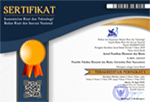Faktor-Faktor yang Mempengaruhi Penghindaran Pajak
DOI:
https://doi.org/10.33633/jpeb.v5i1.2645Abstract
This study aimed to analyze the influence of ROA, Leverage, size, tax loss carry forwards, institutional ownership, and the risk companies against tac avoidance. Tax avoidance is a dependent variable in this study. Tax avoidance is measured by effective cash rate (CETR). The independent variables studied were ROA, Leverage, size of the company, tax loss carryforwards, institutional ownership, and the risk companies. This study using purposive sampling method with a sample 30 companies losted in the Indonesia Stock Exchange in 2011–2018. Data analysis was performed with the classical assumption and hypothesis testig with multiple linier regression method. The results of this study indicate that the ROA, Leverage, size, tax loss carry forwards, institutional ownership, and the risk companies significant negative effect on tax avoidance..Keywords: Return On Assets (ROA); Leverage; Size Of The Company; Tax Loss Carryforwards; Institutional Ownership; The Risk CompaniesPenelitian ini bertujuan untuk menganalisis pengaruh ROA, leverage, ukuran perusahaan, kompensasi rugi fiskal, kepemilikan institusional, dan risiko perusahaan terhadap penghindaran pajak. Penghindaran pajak merupakan variabel dependen dalam penelitian ini. Penghindaran pajak diukur dengan ROA, leverage, ukuran perusahaan, kompensasi rugi fiskal, kepemilikan institusional, dan risiko perusahaan. Penelitian ini menggunakan metodepurposive sampling dengan sampel 30 perusahaan manufaktur yang terdaftar di BEI pada tahun 2011 – 2018. Analisis data dilakukan dengan uji asumsi klasik dan pengujian hipotesis dengan metode regresi linier berganda. Hasil dari penelitian ini menunjukkan bahwa ROA, leverage ukuran perusahaan, kompensasi rugi fiskal, kepemilikan institusional dan risiko perusahaan tidak berpengaruh terhadap penghindaran pajak.Kata Kunci: ROA; Leverage; Ukuran Perusahaan; Kompensasi Rugi Fiskal; Kepemilikan Institusional; Risiko PerusahaanReferences
Ardyansah, Danis dan Zulaikha, 2014, “Pengaruh Size, Leverage, Profitability, Capital Intensity Ratio, dan Komisaris Independen terhadap Effective Tax Rate (ETR)â€. Diponegoro Journal of Accounting. Vol.3 No.2, pages: 1-9.
Darmawan, I Gede Hendy dan Sukartha, I Made, 2014, “Pengaruh Penerapan Corporate Govermance, Leverage, Return on Assets, dan Ukuran Perusahaan pada Penghindaran Pajakâ€.E-Jurnal Akuntansi Universitas Udayana. 9.1 (2014): 143–161. ISSN:2302-8556.
Direktorat Jenderal Pajak,2015,www.pajak.go.id
Ghozali, Imam, 2011, APLIKASI ANALISIS MULTIVARIATE dengan Program IBM SPSS, Universitas Diponegoro, Semarang.
Global Reporting Initiative, www.globalreporting.org/AboutGRI
Hanlon, M & Heitzmen, S, 2010, Review Penelitian Pajak.Jurnal Akuntansi dan Ekonomi 50 : 127-128
I Gusti, A & Ketut A., 2014,“Pengaruh Corporate Governance, Profitabilitas dan Karakteristik Eksekutif pada Tax Avoidance Perusahaan Manufakturâ€, E-Jurnal Akuntansi Universitas Udayana 9.2, ISSN : 2302-8556.
Kurniasih, Tommy dan Sari, M Ratna Maria, 2013, â€Pengaruh Return On Assets, Leverage, Corporate Governance, Ukuran Perusahaan dan Kompensasi Rugi Fiskal pada Tax Avoidanceâ€. Jurnal Akuntansi, Fakultas Ekonomi, Universitas Udayana. ISSN 1410-4628.
Ngadiman & Christiani, 2014, â€Pengaruh Leverage, Kepemilikan Institusional, dan Ukuran Perusahaan terhadap Penghindaran Pajak (Tax Avoidance) pada Perusahaan Sektor Manufaktur yang Terdaftar di BEI 2010-2012â€, Jurnal
Akuntansi, Vol. XVII No. 03.
Pradipta Hayu Dyah, Supriyadi, 2015, “Pengaruh Corporate Social Responsibility (CSR), Profitabilitas, Leverage, dan Komisaris Independen terhadap Praktik Penghindaran Pajakâ€, Simposium Nasional Akuntansi XVII Universitas Sumatera Utara, Medan 2015.
Prakosa, Kesit Bambang, 2004, â€Pengaruh Profitabilitas, Kepemilikan Keluarga, dan Corporate Governance terhadap Penghindaran Pajak di Indonesiaâ€,Simposium Nasional Akuntansi XVII.
Rinaldi dan Charoline Cheisviyany, 2015, “Pengaruh Profitabilitas, Ukuran Perusahaan, dan Kompensasi Rugi Fiskal terhadap Tax Avoidanceâ€. SNEMA Fakultas Ekonomi Universitas Negeri Padang. ISBN: 978-602-17129-5-5.
Rusli, Teguh M., Yessi M., 2015, “Pengaruh Return On Assets, Leverage, Ukuran Perusahaan, KOmpensasi Rugi Fiskal, dan Kepemilikan Intitusi terhadap Penghindaran Pajakâ€. Simposium Nasional Akuntansi 18 Universitas Sumatera Utara, Medan.
Suyanto, Krisnata Dwi dan Suparmono, 2012,“Likuiditas, Leverage, KOmisaris independen dan Manajemen Laba Terhadap Agresivitas Pajak Perusahaanâ€. Jurnal Keuangan Dan Perbankan. Volume 16. Nomor 2 Pages: 166-167
Swingly, Calvin dan Sukartha, Made, 2015, †Pengaruh Karaktereksekutif, Komite Audit, Ukuran Perusahaan, Leverage, dan Sales Growth pada Tax Avoidanceâ€.Jurnal Akuntansi, Universitas Udayana Volume 10.Nomor 1. Halaman 47-62. ISSN 2302-8556.
Tridahus S., Fitri D., 2015, “Pengaruh Komite Audit, Kualitas Audit, Kepemilikan Institusional, Risiko Perusahaan, dan Return On Assets terhadap Tax Avoidanceâ€. Jurnal Bisnis dan Manajemen. Volume 5. Nomor 2.
www.idx.co.id
Downloads
Published
How to Cite
Issue
Section
License
The copyright of the received article shall be assigned to the journal as the publisher of the journal. The intended copyright includes the right to publish the article in various forms (including reprints). The journal maintains the publishing rights to the published articles.
This work is licensed under a Creative Commons Attribution 4.0 International License.


.png)









